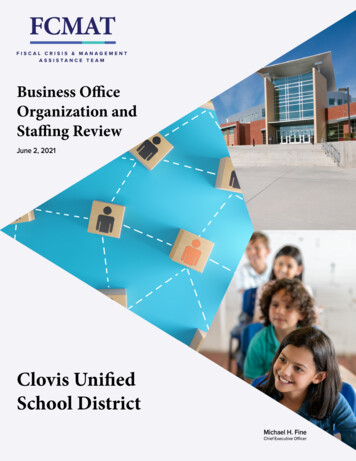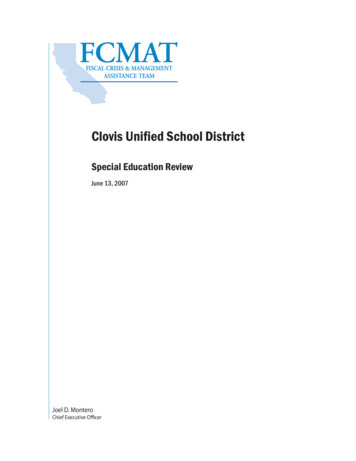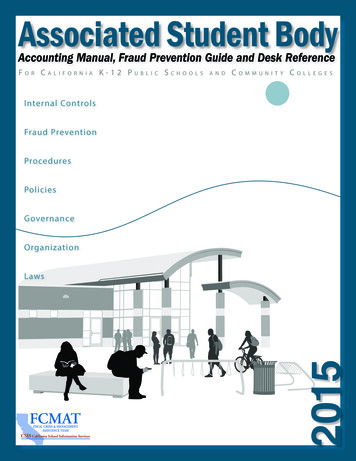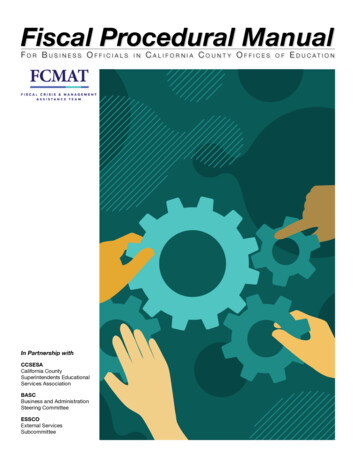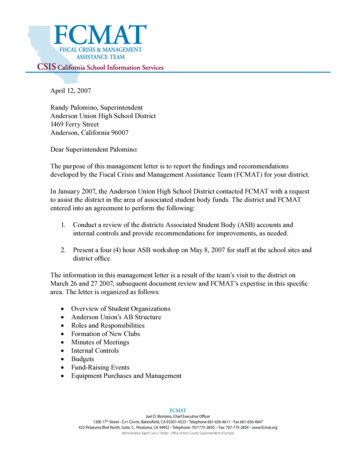
Transcription
April 12, 2007Randy Palomino, SuperintendentAnderson Union High School District1469 Ferry StreetAnderson, California 96007Dear Superintendent Palomino:The purpose of this management letter is to report the findings and recommendationsdeveloped by the Fiscal Crisis and Management Assistance Team (FCMAT) for your district.In January 2007, the Anderson Union High School District contacted FCMAT with a requestto assist the district in the area of associated student body funds. The district and FCMATentered into an agreement to perform the following:1.Conduct a review of the districts Associated Student Body (ASB) accounts andinternal controls and provide recommendations for improvements, as needed.2.Present a four (4) hour ASB workshop on May 8, 2007 for staff at the school sites anddistrict office.The information in this management letter is a result of the team’s visit to the district onMarch 26 and 27 2007, subsequent document review and FCMAT’s expertise in this specificarea. The letter is organized as follows: Overview of Student OrganizationsAnderson Union’s AB StructureRoles and ResponsibilitiesFormation of New ClubsMinutes of MeetingsInternal ControlsBudgetsFund-Raising EventsEquipment Purchases and ManagementFCMATJoel D. Montero, Chief Executive Officer1300 17th Street - CITY CENTRE, Bakersfield, CA 93301-4533 Telephone 661-636-4611 Fax 661-636-4647422 Petaluma Blvd North, Suite. C, Petaluma, CA 94952 Telephone: 707-775-2850 Fax: 707-775-2854 www.fcmat.org.Administrative Agent: Larry E. Reider - Office of Kern County Superintendent of Schools.
Findings and RecommendationsOverview of Student OrganizationsStudents in California’s public schools may legally raise money and make decisions on howto spend it through groups called Associated Student Body organizations (ASBs), which mustbe made up of current students. The existence of ASB organizations and the management ofASB funds also represent an opportunity for students to learn leadership skills and some of theprinciples of operating a small business while contributing to their school and benefiting fellowstudents.Student organizations in middle schools and high schools are called organized student bodyorganizations (organized ASB) because the students organize their activities around studentclubs and a student council. These students are primarily responsible for their organizationsand, through the student council and student club leadership, are to develop budgets, plan fundraisers, decide how the funds will be spent, and approve payments. The school Principal, ASBBookkeeper and club advisor(s) assist and advise, while the students make the actual decisionswith the assistance of adults. Unorganized ASBs are primarily for elementary sites, adulteducation sites and K-8 schools, and will not be addressed in this letter since this informationdoes not apply to the specific district.In addition to what is mandated by laws and regulations, ASB operations must also use goodbusiness practices, sound internal controls, and practical information based on current ASBoperations in other California schools. Some ASB responsibilities are not addressed by law. Mostare based on processes and procedures necessary to protect the assets raised and the variouspeople involved in ASB operations.Anderson Union’s ASB StructureThe Anderson Union High School District has a general student council with the appropriateofficers at each school site. Various other clubs also exist. With the exception of the charter highschool, the clubs do not meet regularly or keep minutes of meetings. Neither the council nor anyof these clubs adopt and maintain budgets as the year proceeds. In most cases, students approveexpenditures only after they have occurred, which is when the check is being issued. While thereare exceptions, the level of noncompliance in these areas suggests that the adults and not thestudents make most decisions on ASB funds. Unless the students become more involved in theprocess and fulfill their suitable roles, the funds currently in ASB accounts more appropriatelybelong in district site accounts, where it is appropriate for adults to exercise control over them.Roles and ResponsibilitiesMany people are involved in administering and supervising student organization activities. Theyinclude the following:
Governing Board - The Governing Board is ultimately responsible for everything that happensin the district, including the activities of student organizations. Education Code § 48930 grantsthe Governing Board authority to approve the formation of district student body organizations.However, governing boards are not required to approve the formation of these organizations.As a last resort, some districts have chosen to terminate student organizations and fund-raisingbecause of continuous and severe out-of-compliance issues that included fraud.The Education Code also grants governing boards the authority to establish the parametersof district operation through board policies and regulations. These policies and regulationsmust contain information specifying how a student body organization will be established, howthe organization’s activities will be supervised, and how the organization’s finances will beoperated and managed. The district administration is responsible for establishing and monitoringprocedures that implement the governing board’s policies and regulations.A comprehensive board policy is the cornerstone of sound practices in student organizations.Districts should also develop and implement a comprehensive ASB manual for all schools thathave student organizations. While Anderson Union lacks an ASB manual, the district has severalapproved board policies, including the following: Board policy 6145.5(a), Student Organizations and Equal Access, dated January 20, 2004Board policy 6145.8 (a), Activity Funds Management, dated August 15, 1988Board policy 3450 (a), Money in School Buildings dated August 15, 1988Board policy 1321 (a), Solicitation of Funds From and by Students, dated October 19,2004The district should review these board policies, comparing them with examples of morecurrent and informative board policy. Samples of these policies will be provided at the FCMATworkshop scheduled for May 8, 2007 and include the following: Solicitation of funds from and by studentsAdvertising and promotionStudent activity fundsManagement of district assets/accountsOther food salesSuperintendent - The district Superintendent ensures the implementation of board policiesand makes certain that district staff members follow them. In addition, the Superintendent isresponsible for establishing the procedures to be utilized by the staff in complying with boardpolicy. This is normally accomplished through administrative regulations. The Superintendentshould communicate the importance of the following issues and ensure that they are carried out: The Superintended functions as the “supervisor” of the student body organizationactivities.
All district staff members are familiar with and understand the importance of followingall policies established by the Governing Board, including those on ASBs.All district staff members understand the importance of the problems noted in the annualaudit.Immediate action is taken to investigate any allegations about improprieties regardingASB funds. Appropriate action is taken if the allegations are confirmed.Anderson Union has approved one administrative regulation related to board policy 6145.8(a),Activity Funds Management, dated August 15, 1988. However, because the district lacks an ASBmanual, this administrative regulation is insufficient to provide adequate guidance to the manypeople involved in ASB operations.The district should review its administrative regulations, comparing them with examples ofmore current and informative regulations. Samples will be provided at the FCMAT workshopscheduled for May 8, 2007 and include the following: Solicitation of funds from and by studentsManagement of district assets/accountsOther food salesBusiness Office Staff - The district business office staff is responsible for the general oversight ofstudent body activities. In this capacity, the business office staff should perform the following: Serve as a resource and answer questions from the site staff.Develop and update the district’s ASB manual based on input from the site staff, studentorganizations and district auditors. The questions that are asked throughout the year andthe findings noted by the auditors should also be taken into consideration when updatingthe manual.Provide training at least annually on the district’s ASB manual or procedures. Thisincludes providing new staff members and student council members with training andcopies of the manual.Make periodic visits to sites to review the procedures in operation and answer questions.It is a good practice to visit each site at least once a year and more often for sites thatappear to be having problems or continue to have audit findings.Obtain and review financial reports from the school sites at least quarterly.Review reconciled bank statements for all the school sites regularly, preferably monthly.Work with the site staff to respond to the problems noted in the annual audit and developcorrective actions to resolve these problems.Follow up on all issues regarding the administration of student organizations.Develop accounting procedures for recording and controlling the financial transactions ofthe student body organization.Periodically review procedures to make sure they conform to the prescribed accountingprocedures.
The district carries out most of these responsibilities. Staff members indicated that they feltsupported by the district office when they had questions or concerns. One exception was aperceived lack of timeliness in purchase order processing, and a concern that all payments topeople are required to go through the district office. However, purchase order issues seem tooccur infrequently, and the district recently assumed responsibility for paying all people throughthe payroll system for ASB, with the sites paying actual vendors/companies. This practice willprovide for additional monitoring of those being paid to perform certain duties. Additionaloversight in this area is important because many staff members and students were being paidfrom the ASB system without adherence to internal revenue rules and regulations.The business office should either develop its own ASB manual or use FCMAT’s ASB manualand desk reference. The chief business official (CBO) uses FCMAT’s manual, and this documentcould be provided to all site staff members associated with ASB. In addition, the district shouldprovide staff members with annual training either internally or through an outside organization.FCMAT has been contracted to provide a workshop on ASB issues in May 2007, and a FCMATASB manual will be distributed to each attendee. The district should continue to mandate thatstaff members attend this type of training in the future even if they attended in the past. Thebusiness office staff should also perform regular site visits as a type of internal audit to ensureadherence to proper procedure.Principal/Site Administrator - The role of principals/site administrators varies by school leveland size. While the principal has ultimate responsibility for all activities at the school site, manyresponsibilities for ASB management functions may be delegated to other staff members. Theprincipal is directly responsible for student body organization financial activities and must ensurethat they conform to established policies and procedures. At the secondary level, the designeegenerally is an assistant principal or ASB advisor.For organized ASBs like those at Anderson Union, the responsibilities of the principal/siteadministrator are different from those at “unorganized” entities because the students moreactively govern ASB activities. The principal/site administrator is responsible for the followingmajor duties, many of which are delegated to an ASB advisor: Communicating and enforcing student organization policies and procedures to the staffand students.Ensuring that a student council is established and that each club has a certificated advisor.Providing supervision to the ASB advisors.Ensuring that minutes are kept of all ASB and club meetings.Providing supervision to the ASB bookkeeper. This includes reviewing monthly bankstatements and financial statements.Ensuring that ASB funds are raised and expended in accordance with applicable laws anddistrict policies and procedures.Deciding how many fund-raising events will be held each year, and ensuring that they areappropriate.Receiving proper approval and scheduling the fund-raising events.Reviewing and approving all club constitutions.
Working with the district’s business office regarding training, implementation of goodbusiness practices, internal controls and resolution of audit findings.Reporting any suspected fraud or abuse to the district business office.The principal/site administrator may delegate some or all of these activities to a site employeesuch as a vice-principal or teacher. Although Anderson Union utilizes this approach, oneprincipal is more involved in the process than the other. Even if some responsibilities have beendelegated to other staff members, the principals should review the monthly financial statementsand bank reconciliations to monitor the type of funds flowing through these accounts. This is notoccurring on an ongoing basis at all the district’s schools.ASB Advisor – At secondary schools, a certificated employee must be assigned as an advisorto the general student council and each club. As the principal’s designee, the ASB advisor isusually responsible for all the previously mentioned functions and also ensures that all requiredprocedures are followed. The advisor works daily with students in clubs and the student council,supervising the activities of these groups and serving as the link with the ASB bookkeeperand the principal/site administrator. When any ASB organization or club holds fund-raisingevents, the advisor is responsible for ensuring that adequate planning and internal controls areestablished, that all the funds are properly accounted for, and that these funds are forwarded tothe ASB bookkeeper along with all the appropriate paperwork. The advisor(s) also works withstudents to prepare the annual budget and revenue projection estimates, ensuring that only validexpenditures are made and authorized from the different club funds.At Anderson Union, these advisors do not assist in scheduling regular meetings, keepingadequate minutes, and adopting and maintaining budgets. This information should be compiledand forwarded to the general student council, which should review it monthly and maintain ageneral schedule of meetings, minutes, and budgets.Each club should also have its own constitution. While the general student council at each districtschool has a constitution, the individual clubs do not. FCMAT has included a sample constitutionwith this management letter.ASB Bookkeeper/Clerk -At each school site, a staff member is responsible for maintainingaccounting records for ASB funds. Each site visited also has a clerk that is responsible formaintaining the accounting records for student organizations.The ASB Bookkeeper/Clerk is responsible for ensuring the following: That all ASB funds are safeguarded while at the school site and deposited in the ASB’sbank account in a timely manner (within a few days, but no less than weekly). That accurate financial records are maintained of all ASB financial transactions inaccordance with established procedures. That bank reconciliation is completed each month.
That laws, district policies and procedures related to ASB funds are followed. Businesspolicies and procedures related to ASB must also be followed, including those foraccounting, purchasing, budget, and payroll. That any suspected fraud or abuse is reported to the school principal/administrator ordistrict business office.The ASB Bookkeeper/Clerk is fulfilling these obligations satisfactorily. However the clerkdoes not receive several pieces of information that would facilitate this process, including clubbudgets, minutes and constitutions. The clerk should be provided with these documents as soonas the district begins to generate them.Only the charter school notifies the clerk about upcoming fund-raisers. This makes it impossiblefor the clerk to ensure that funds from the other schools are received in a timely manner and thatall anticipated receipts have been submitted. This is a significant internal control weakness.The forms used by each site are thorough and understandable. However, as was previouslymentioned, students must approve expenditures prior to purchase.The district issues a number of reimbursements to parents and staff members for itemspurchased. In most cases, students do not approve these reimbursements beforehand, and nopurchase order or other documentation is processed that grants anyone authority to make thepurchase. For sound internal controls, the district must draft an internal purchase order togenerate proof of previous approval, regardless of whether the vendor requires one.Student Council - In middle, junior and high schools, a student council must oversee all theschool’s student clubs. In an organized ASB, the student council represents the students and hasprimary authority on how to expend funds raised. Primary responsibilities include the following: Developing and adopting the annual budget,Authorizing fund-raising events,Approving expenditures from student funds.Student councils at the two comprehensive high schools do not perform these functions. Thesecouncils also do not receive minutes, fund-raising information and budgets from all school clubs.This area requires immediate attention.
Formation of New ClubsIn middle, junior and high schools, organized ASBs normally have many individual clubs, eachwith a specific focus and its own requirements, functioning under the primary student bodyorganization. Primary guidance is shared by the principal, faculty advisors, and student body.To become a recognized part of the student body organization, a club must be composed entirelyof students currently enrolled at the site. For financial purposes, these clubs are known as trustaccounts, and they must have the approval of the student council and the principal, at the board’sdirection. All aspects of a student organization must be included in one of its trust accounts. Allclubs should follow regulations stated in the ASB constitution on the formation of school clubs.Any group of students may apply for permission to form a club by submitting a proposed charterof constitution to the ASB, or by submitting an application. The general ASB constitution shoulddetail the necessary steps to accomplish this.To promote good governance, the principal should require students interested in forming a newschool club to submit a formal application that is endorsed by a teacher or other school facultymember who agrees to serve as the club advisor for the entire school year. The Education Coderequires club advisors to be certificated employees of the school district. Additional informationshould include the title, powers and duties of the officers and the manner of their election, scopeof proposed activities, and name of the organization. FCMAT will provide the district with asample application form for student clubs at its May 8 workshop.Some school districts require all ASB organizations to submit an application each year. Thisensures the district has on file the most current constitution and bylaws and is apprised of theclub’s current officers, members and advisor.The general student council and each club must prepare and adopt an official constitutionthat includes the organization’s name and purpose as well as the framework for its operation.This document should include clear policies and rules for student governance of the studentorganization or club. A set of bylaws that identifies operational parameters is also an importantcomponent although it is required only of the student council.At a minimum, the constitution should include the following: Background information on the organization.The name of the organization.The purpose of the organization.The type of activities that the organization will conduct.The membership requirements for the organization, including the eligibility requirements.The definition of a quorum.How the constitution is amended.Information on the officers and meetings.The titles and terms of office of officers.The duties of officers.
How officers are elected and requirements of eligibility.Whether the club/organization will be represented on the student council.How representatives to the student council other than officers will be selected.How representatives to the student council will be selected.The qualifications for eligibility on the student council.The term limits on the student council.How club advisors will be appointed.The time, frequency, and place for meetings.Financial information.How and when the budget is prepared.How expenses are approved.The person who will monitor the budget.What types of financial statements and reports will be generated and distributed.How committees will be appointed.How clubs in the student body organization will be formed, including their purpose,method of organization and discontinuance, financial activities and requirements forconstitution and/or bylaws.A set of sample constitutions and bylaws will be provided at FCMAT’s May 8 workshop.Because all student clubs and trust accounts are part of the general ASB, their funds shouldbe transferred to the general ASB when a club becomes inactive unless there are specificinstructions to do otherwise. The district’s board policy on ASB or the ASB constitution and/orbylaws should define an inactive club, state what will occur with funds from these clubs, andindicate where these funds will be transferred. An inactive club could mean any club that has nofinancial activity for more than 18 months unless the district has a different definition.Minutes of MeetingsBecause organized student groups follow a formal process of student governance, the studentcouncil and each club must prepare and maintain at each meeting a record of proceedings, whichis called the minutes. Minutes also demonstrate that the student council or club has followed theASB organization’s policies and procedures.Minutes should include financial matters pertaining to the budget, approval of fund-raisingventures, and expenditure authorizations. Minutes are not a verbatim transcript of the meeting,but a concise summary of the essential matters discussed. Using abbreviations for specialprojects or groups reduces the value of minutes in the future.Although the form of the minutes might vary from organization to organization, at a minimum,the following information should be documented in the minutes:
The name of the club or organization holding the meeting.The date, time, and place of the meeting.The names of those in attendance.The name of the presiding officer.An approval of the minutes from the previous meeting.The items discussed or reported on during the meeting.A report on activities of standing committee(s) or special committee(s).Any action taken during the meeting such as whether the budget was amended or theexpenses were approved.The results of any votes taken, including who made a motion, who seconded the motion,and anyone in opposition, if applicable.Reports on any communication to the ASB.A listing of any unfinished business.The date and time of the next meeting.The time the meeting adjourned.The person who prepared the minutes.Any information introduced at the meeting, such as project outlines and letters, should beattached to the original copy of the minutes and maintained on file. The club secretary or personwho took the minutes should also sign them when they are completed.At its May 8 workshop, FCMAT will provide the district with a minutes form that may assist theclubs as they begin to fulfill this requirement.At a regularly scheduled student council or club meeting, students should review and approvethe minutes of the previous meeting. The secretary should maintain a binder of all the approvedminutes for the school year.A document titled “Let’s Get the Meeting Moving” will be provided at the May 8 workshop.Some districts use this document to inform club members about appropriate topics of discussionas well as a method of discussion.Internal ControlsInternal controls are the policies and procedures that an organization establishes to perform thefollowing: Safeguard and preserve the organization’s assets.Promote successful fund-raising ventures.Protect against improper fund disbursements.Ensure that unauthorized obligations cannot be incurred.Provide reliable financial information.Reduce the risk of fraud and abuse.Protect employees and volunteers.10
Establishing effective internal controls for fund-raising events significantly decreases the riskthat event participants will be accused of impropriety. Disagreements between principals,advisors, teachers, parents and/or students or community members sometimes result in falseaccusations that are difficult to disprove without sound internal controls.Internal controls include segregating duties by employee functions so that one person does nothandle a transaction from beginning to end. The individuals performing functions that need to besegregated include the following: Those who initiate or authorize transactionsThose who execute the transactionsThose with the responsibility for the item resulting from the transactionThe basic components of internal controls include the following: Policies and procedures that are based on laws, regulations, and sound business principlesare established, implemented and maintained.Policies and procedures are communicated to those involved, e.g., advisors and students.All individuals who are expected to carry out the policies and procedures are trained.More than one person is trained for each job.Adequate documentation of all procedures is prepared and maintained, such as anymanuals and forms.Periodic monitoring is performed throughout the year, including oversight by theprincipal, ASB advisor, district business office, and completion of the annual audit.Other controls include internal audits of ASB operations at different sites, and the independentannual audit that is performed at the end of each year.Effective internal controls do not eliminate the possibility of errors or fraud but they can decreasethem. Since few entities have perfect internal control structures in place, it is imperative thatmanagement develop techniques to offset any weaknesses. FCMAT attached to this letter achecklist that principals, advisors, students, and district officials can use to evaluate the internalcontrols of their ASB organizations.The district’s sites use effective internal controls overall, but weaknesses exist in the areasof handling cash and authorizing expenditures. Teachers, coaches and other staff memberssometimes handle excessive amounts of cash without requiring tickets or other receipts. Thesefunds are then forwarded to the clerk or another staff member.The district must also ensure that three signatures of approval are obtained before making anexpenditure. Student signatures are not currently obtained prior to purchase, but they should be.11
BudgetsThe school district Governing Board must establish procedures for the preparation and controlof student body organization budgets. A budget is a financial plan for a specific period of time. Abudget allows the ASB organization to estimate at the beginning of the school year its financialcondition at the end of the year.In middle, junior and high schools, the student council may have to make commitments andenter into contracts at the beginning of the year, before any funds are raised. A budget allows theorganization to estimate its revenues for that year and compare them with planned expenses.Budgets are usually prepared for a one-year period. Both the general student council and eachindividual club should develop their annual goals and include a plan to reach those goals in thebudget document by determining the following: Estimated Revenues: The fund-raisers that will be held.Estimated Expenses: The cost for these fund-raisers and any planned programs oractivities.Estimated ending reserves and club carryover: The amount left after expenses are paidand whether this will be sufficient to accomplish the stated goals.Developing and managing budgets should be a part of the process of teaching students aboutbusiness operations. Budgeting is also a valuable life skill that can help students manage theirpersonal finances.Budget monitoring is the process of regularly comparing actual revenues and expenses to thebudget. Students and the advisor should monitor the budget at least monthly. This will allow foradequate time to adjust plans if the budget is not realistic or if the planned goals will not be metbecause of lower revenues or higher expenditures.If any problems are noted during budget monitoring, the students can revise the budget.Significant changes should be made for variances of 10 percent or more. The advisor and/orprincipal should also approve all budget changes. Anderson Union may want to establish aspecific time line for budget revisions and include this in board policy.The principal, advisor and students should ensure that funds raised by students during a givenschool year are spent on behalf of those students. Reasonable carryover balances often areused as seed money for a project that will be completed i
The information in this management letter is a result of the team's visit to the district on March 26 and 27 2007, subsequent document review and FCMAT's expertise in this specific . The Anderson Union High School District has a general student council with the appropriate officers at each school site. Various other clubs also exist. With .
